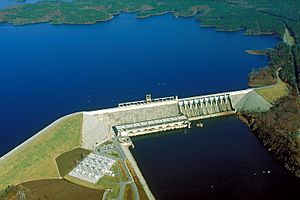Richard B. Russell Dam facts for kids
Quick facts for kids Richard B. Russell Dam |
|
|---|---|

Richard B. Russell Dam
|
|
| Location | Abbeville County, South Carolina / Elbert County, Georgia, USA |
| Coordinates | 34°01′30″N 82°35′39″W / 34.02500°N 82.59417°W |
| Construction began | 1974 |
| Opening date | 1985 |
| Construction cost | $626 million USD |
| Operator(s) | U.S. Army Corps of Engineers |
| Dam and spillways | |
| Type of dam | Embankment, concrete-gravity |
| Impounds | Savannah River |
| Height | 210 ft (64 m) (thalweg) |
| Length | .98 mi (1.58 km) |
| Reservoir | |
| Creates | Richard B. Russell Lake |
| Catchment area | 2,890 sq mi (7,500 km2) |
| Surface area | 26,650 acres (10,780 ha) |
| Power station | |
| Type | Pumped-storage |
| Turbines | 8 total: 4 x 75 MW (101,000 hp), 4 x 75 MW reversible |
| Installed capacity | 600 MW (800,000 hp) |
| Annual generation | 465.5 GWh (1,676 TJ) |
The Richard B. Russell Dam is a huge structure built on the Savannah River. It sits right on the border between South Carolina and Georgia. This dam creates a large body of water called Richard B. Russell Lake.
The U.S. Army Corps of Engineers built this dam between 1974 and 1985. Its main jobs are to control floods and make electricity from water. It also helps with fun activities like boating and fishing. The dam helps manage the river's flow and supports wildlife.
The dam is made of two main parts: a strong concrete section and long earthen embankment sections. The concrete part is about 1,904 feet long and stands 210 feet tall. Inside, it holds a power plant that can produce 600 megawatts of electricity. The Richard B. Russell Dam is the last big dam built by the U.S. Army Corps in the Savannah River area.
Contents
Building the Dam: A Look Back
The idea for this dam started with a law called the Flood Control Act of 1966. This law allowed a new lake and dam to be built on the Savannah River. It was first going to be called Trotters Shoals Lake and Dam.
Renaming the Dam
In 1987, the dam and lake were renamed. They were named after Richard Brevard Russell, Jr., a very important senator from Georgia. A senator is a person elected to make laws for their state and country. At the same time, another nearby lake, Clarks Hill Lake, was renamed Lake Strom Thurmond.
Construction Timeline
Work on the dam started in 1974. The process of filling the lake began in October 1983. By December 1984, the lake was completely full. The first part of the power plant, with four large generators, started making electricity in January 1985.
Later, in 1992, four more special generators were added. These new generators can work in two ways. They can make electricity, but they can also pump water back into the lake. This special ability is called pumped-storage hydroelectricity.
How the Dam Works
The Richard B. Russell Dam is very long, stretching for about 5,224 feet. The main concrete part is 1,904 feet long. On both sides of the concrete section, there are long earthen walls called embankments. These add another 3,320 feet to the dam's length.
Controlling Water Flow
The concrete part of the dam holds the power plant and the spillway. A spillway is like a giant drain that helps control the water level in the lake. It has ten large gates, each 50 feet wide and 45 feet tall. These gates can open to let water out, which helps prevent floods and keeps the lake at the right level.
Making Electricity
The dam's powerhouse is 690 feet long. It contains eight large generators, each able to produce 75 megawatts of power.
Types of Generators
- Four of these generators are conventional turbines. They use the force of water flowing downhill to spin and create electricity.
- The other four are reversible turbines. These are very special because they can also work in reverse. They can pump water from the river below the dam back up into the lake.
Pumped-Storage Power
The Russell Dam is mainly a peaking facility. This means it makes electricity when people need it most, like during hot summer afternoons. During times when electricity is cheaper and not many people need it (like late at night), the reversible pumps push water from Lake Thurmond back into Lake Russell. It's like "recharging" the lake. Then, when electricity demand is high, this stored water is released to generate more power. The Southeastern Power Administration manages the electricity produced by the dam.

